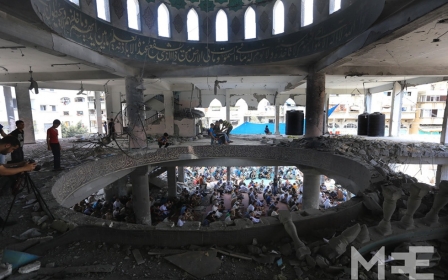Mission imprecision: the unexploded ordnance war

In September of 2006, Haaretz quoted the head of an Israeli Army rocket unit on his military’s performance during the recent 34-day war on Lebanon: “What we did was insane and monstrous, we covered entire towns in cluster bombs.”
As the article explains, the United Nations estimated at the time that approximately 40 percent of cluster rounds fired by Israel had failed to explode. This is why, despite intensive and ongoing cleanup efforts by Lebanese and international organisations, we still continue to see headlines like: “18-year-old Lebanese killed by Israeli cluster bomb.”
The Lebanese in this particular case was a shepherd who stepped on an unexploded bomb on a farm in south Lebanon, but aside from shepherds and farmers, other popular casualties of belatedly exploding munitions include sheep, goats, and children who often mistake the deadly items for toys.
Haaretz also quoted the response of the Israeli military spokesperson to the allegation that Israel had violated international law by saturating Lebanon with cluster bombs: “International law does not include a sweeping prohibition of the use of cluster bombs.”
Fair enough. But it does happen to prohibit their use against civilians. And the fact that civilians in Lebanon continue to be killed and maimed by these de facto landmines simply underscores the egregiousness of the violation.
This, of course, is Israel’s modus operandi: creating murderous facts on the ground with one hand while denying or euphemising its behavior with the other. At the end of the day, physical and linguistic domination go hand in hand.
Clusterf**ked
Israel’s latest genocidal pursuits in Gaza - euphemised as “self-defense” - have enabled the Israeli military to apply another coat of paint to Arab territory which we shall call the snazzy shade: “unexploded ordnance,” or UXO for short.
On 13 August, six people were killed by a series of detonations at an ordnance dump. An Italian video journalist was among the fatalities and the story made major headlines; after all, this was not just another boring loss of Arab life.
But despite the brief media flash, we have to remember that death by UXO is a mainstay of existence in the Gaza Strip.
Back in September 2012, the Protection Cluster - a group headed by the UN Office of the High Commissioner for Human Rights - reported the following statistics:
“To date in 2012, there have been 29 civilian UXO victims (18 children) in Gaza: from 2009 to 2012, the total number is 111 (64 children). The number of known UXO civilian casualties has steadily increased in the last two years, reaching an average of four per month in 2012.”
2009, of course, marked the end of a previous Israeli paint job in Gaza: Operation Cast Lead, during which properly-exploding bombs killed approximately 1,400 Palestinians, most of them civilians. Shortly after the Protection Cluster report was issued, another touch-up was required in the form of Operation Pillar of Defense, the eight-day slaughter that transpired in November of 2012.
With regard to the latter event, the Israeli human rights organisation B’Tselem noted that “[f]our times as many uninvolved Palestinian civilians were killed in the final four days of the operation as during the first four days.”
This illustrates a common Israeli approach to life and war: pack in as much destruction as possible before the party’s over.
This logic was also on display during the 2006 rape of Lebanon, and Human Rights Watch specifies that, over 34 days, “the [Israeli Army] rained an estimated four million submunitions on south Lebanon, the vast majority over the final three days when Israel knew a settlement was imminent.”
The great flood
Following the 2006 war, the Council on Foreign Relations recalled that the United States had continuously resupplied Israel’s cluster bomb arsenal throughout the course of the fighting.
Such disregard for human life on the part of the American sugar daddy is hardly surprising given its legacy; the U.S. military alone is responsible for the UXO-induced killing and maiming of over 50,000 Laotians since 1964.
But why, you ask, is such high value placed on weapons with such a high failure rate? To put it simply, their failure is their success, as unexploded weaponry becomes a useful population control mechanism.
In addition to population control in the strictest sense of the term - the literal elimination of bodies - the littering of territory with UXO enables Israel to keep folks in check without having to be physically present. As with the sonic booms regularly executed over Lebanon by the Israeli air force, the UXO harvest denies the country’s residents the luxury of peace of mind and the ability to go about daily tasks un-terrorised.
I was personally introduced to several unexploded munitions during a postwar hitchhiking journey in Lebanon in 2006. In one case, my friend and I were picked up near the Israeli border by two men who had fought with Hezbollah in the war and who derived immense glee from speeding back and forth past a large bomb that had landed on the side of the road. My friend and I eventually abandoned attempts at feigning bravery and resorted to intermittent squawking instead.
In a November 2006 article, Haaretz again quoted the concerned head of the Israeli Army’s rocket unit: “According to the officer, in order to compensate for the rockets' lack of precision, they were told to ‘flood’ the area with them.”
Maybe the Israelis should remember this deluge the next time they complain about a “rain of rockets” from Gaza, the imprecision of which at least translates into minimum rather than maximum lethality.
- Belen Fernandez is the author of The Imperial Messenger: Thomas Friedman at Work, published by Verso. She is a contributing editor at Jacobin magazine.
The views expressed in this article belong to the author and do not necessarily reflect the editorial policy of Middle East Eye.
Photo credit: Hamas security personnel clean up Gaza's beaches of UXO's after Operation Cast Lead (AFP)
New MEE newsletter: Jerusalem Dispatch
Sign up to get the latest insights and analysis on Israel-Palestine, alongside Turkey Unpacked and other MEE newsletters
Middle East Eye delivers independent and unrivalled coverage and analysis of the Middle East, North Africa and beyond. To learn more about republishing this content and the associated fees, please fill out this form. More about MEE can be found here.





